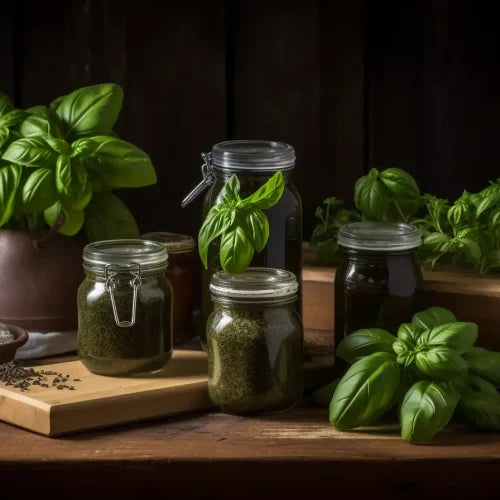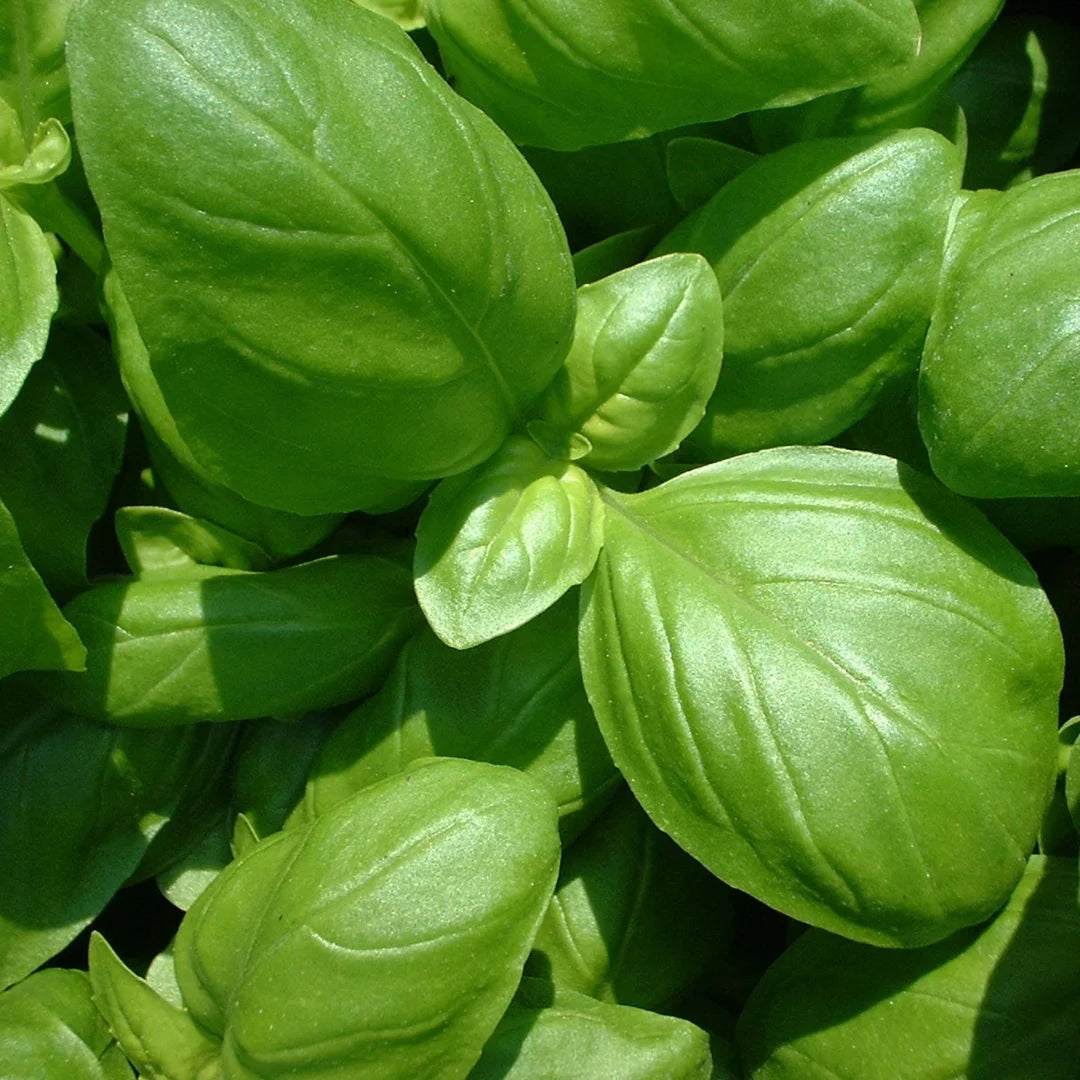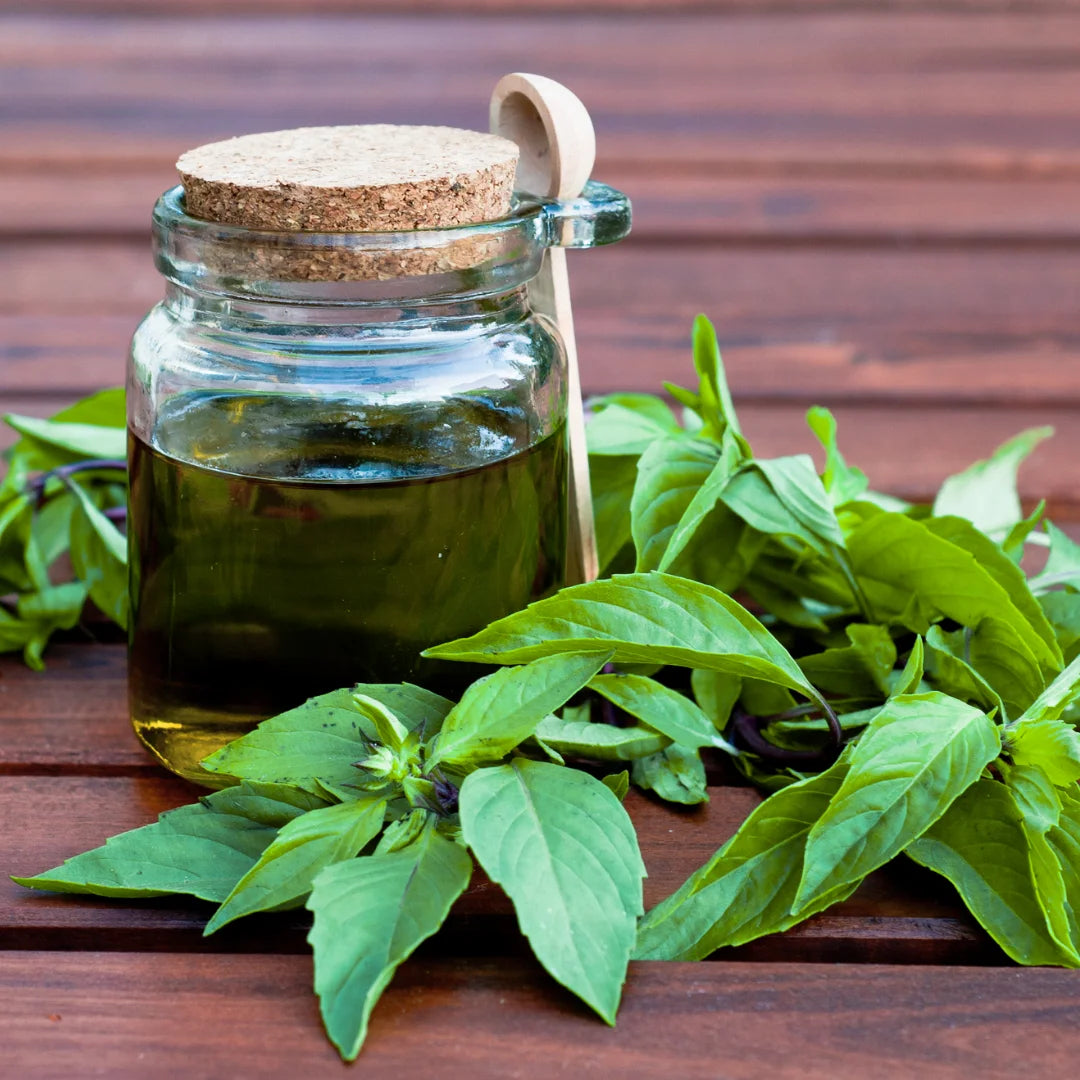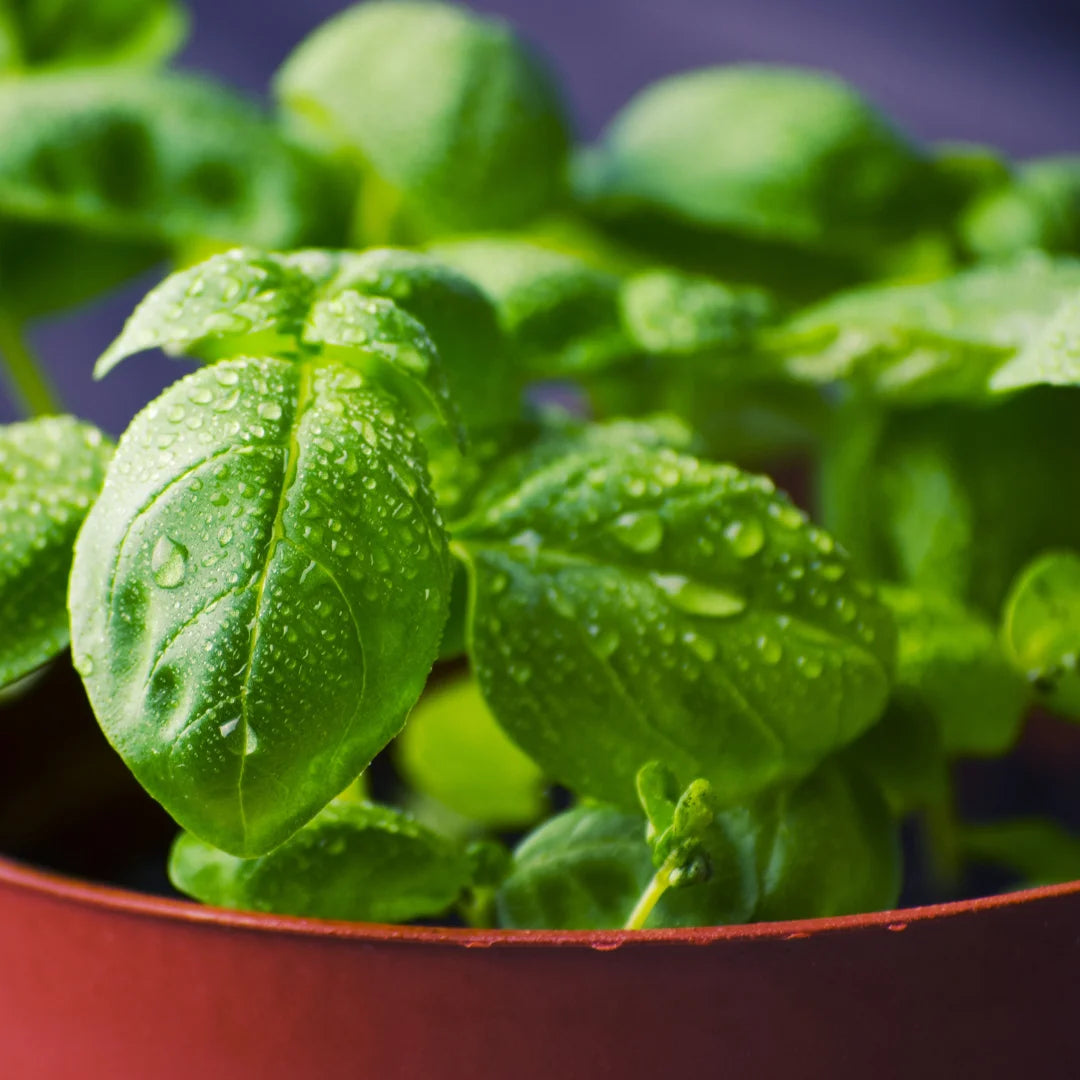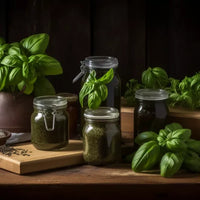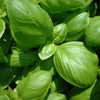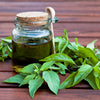As a fellow gardening enthusiast, there’s nothing I love more than the satisfaction of harvesting my own homegrown herbs – especially basil! That fragrant aroma and delightful taste can elevate any dish to new heights.
But if you’re like me, then sometimes your green thumb works a little too well and you end up with more fresh basil than you know what to do with. Well, worry no longer because I’m here to share our comprehensive guide on preserving that bountiful harvest so you can enjoy its goodness all year round.
Not only will this guide help ensure none of your hard work goes to waste, but it’ll also provide an opportunity for you to spread joy through sharing these preserved goodies with friends and family.
Just imagine their faces lighting up as they receive jars filled with homemade pesto or dried basil leaves from your very own garden – talk about serving others in a delicious way!
So let’s dive right in and explore the various methods available for preserving our prized basil crop while creating thoughtful gifts along the way.
Harvesting Basil For Preservation
Did you know that basil is the most widely grown herb in the world? That’s right, this versatile and fragrant plant has found its way into gardens and kitchens across the globe. As someone who loves growing and using basil, I totally understand why it’s so popular. It adds a wonderful flavor to any dish and can even be used as a beautiful garnish.
But what do we do when we have more basil than we can use fresh? We preserve it! And if your heart swells with happiness at the thought of sharing your bountiful harvest with others, then let me guide you through harvesting basil for preservation.
The first step to preserving our beloved basil is knowing when and how to harvest it properly. The best time to pick those aromatic leaves is early morning or late evening – basically, during cooler hours of the day. This ensures that the essential oils responsible for its delightful scent are still intact within the leaves. When cutting your basil stems, always leave at least one set of leaves on each stem; this will encourage continuous growth throughout the season.
Remember, serving others by sharing our abundant harvest starts with proper care and attention to detail.
Now that we’ve covered some tips on harvesting, let’s talk about preparing our freshly picked basil for preservation methods like drying or freezing. Gently wash your harvested leaves under cool water while taking care not to bruise them; after all, they’re delicate little things! Once clean, pat them dry carefully with paper towels or a soft cloth before moving onto your chosen method of preservation.
By following these steps attentively, we’ll ensure our preserved bounty remains flavorful and enjoyable – ready for us to share generously with those around us who could benefit from a touch of green goodness in their lives!
Drying Basil
Now that you’ve successfully harvested your bountiful basil crop, it’s time to move on to the next step – drying this flavorful herb. Drying basil is an excellent way to preserve its amazing aroma and taste while extending its shelf life, so you can enjoy using it in various dishes throughout the year. Let’s dive into the process of properly drying basil.
There are several methods available for drying basil, but here are a couple of tried-and-true favorites:
- Air-drying
- Bundle small bunches of basil with string or rubber bands.
- Hang them upside down in a well-ventilated area away from direct sunlight.
- Oven-drying
- Preheat your oven to the lowest possible temperature (around 170°F / 75°C).
- Spread out the leaves on parchment paper-lined baking sheets without overlapping.
- Place them in the oven for around two hours until they’re dry but not burnt.
Whichever method you choose, remember that patience is key. Properly dried basil will crumble easily between your fingers when it’s ready.
Afterward, store your dried herb in air-tight containers and keep them away from heat and light sources.
Your lovingly preserved basil will be an invaluable ingredient as you prepare meals for family and friends – think about all those delicious pasta dishes! With each use, you’ll spread joy through their taste buds by adding flavor to their lives.
As we wrap up our discussion on drying basil, let us remind ourselves why preserving our harvest can hold such deep meaning. By taking care of these plants and sharing their gifts with others through our cooking efforts, we help foster connections between people over shared experiences at mealtime.
So go ahead – get creative with how you incorporate your beautifully dried basil into recipes that bring warmth and delight into every gathering!
Freezing Basil
You know, I’ve always found freezing basil to be one of the easiest and most convenient ways to preserve my harvest. It’s perfect for those times when you have more basil than you can use right away but don’t want it to go to waste. Plus, there’s nothing quite like having a stash of frozen basil on hand for adding that fresh-from-the-garden flavor to your favorite dishes all year round!
Here’s a handy table that compares three popular methods for freezing basil: whole leaves, chopped with oil, and in ice cube trays:
| Method | Preparation | Best Use |
|---|---|---|
| Whole Leaves | Wash & dry, lay flat on tray | Soups, stews, pasta sauces |
| Chopped w/ Oil | Chop finely, mix with olive oil | Pesto or as a spread |
| Ice Cube Trays | Mince or purée with water/oil | Single-serving portions for sauces, soups or spreads |
Each method has its own advantages depending on how you plan to use your preserved basil later on. Freezing whole leaves is great if you’re looking for versatility; once thawed they retain much of their original texture and can be easily incorporated into various recipes. Mixing chopped basil with a little bit of olive oil before freezing helps prevent browning and makes it easy to scoop out just what you need for pesto or other spreads. Finally, using ice cube trays allows you to create single-serving portions perfect for tossing into soups, sauces or smoothies without any fuss.
So there you have it – preserving your beautiful bounty of basil by freezing couldn’t be simpler! Not only does this help reduce food waste by making sure none of those precious leaves go unused (we love being able to serve others through our gardening efforts!), but it also provides us with ready-to-use ingredients at our fingertips whenever inspiration strikes in the kitchen. Give it a try and see just how easy and rewarding it can be to savor your basil harvest year-round!
Preserving Basil In Oil Or Vinegar
I’m so glad you’re here, because preserving basil in oil or vinegar is one of my favorite methods to savor the flavors of summer all year long! Not only does it allow us to continue enjoying the taste of fresh basil, but it also adds depth and excitement to our meals. Plus, these preserved treats make fantastic gifts for friends and family who appreciate homegrown goodness.
Let me share with you some key tips on how to get started with this simple yet delightful preservation technique:
- Choose high-quality olive oil or vinegar: A good base ensures a better end product.
- Use clean and dry jars: This will prevent any contamination that may spoil your beautiful bounty.
- Blanch the basil leaves briefly: Doing this helps preserve their vibrant color and flavor.
- Store properly: Keep your infused oils or vinegars in a cool, dark place to prolong their shelf life.
Now that we’ve covered those essential pointers, let’s dive into making our very own preserved basil concoctions!
For an oil infusion, start by blanching your basil leaves for just a few seconds before plunging them into ice water. Pat them dry thoroughly; remember that moisture can lead to spoilage. Then layer the leaves between paper towels until completely dried out from excess water before adding them to your jar filled with quality olive oil.
For a vinegar infusion, skip the blanching step – simply add freshly washed and dried basil leaves directly into a glass jar filled with white wine or apple cider vinegar. Seal tightly and store either method away from direct sunlight for at least two weeks to develop robust flavors!
Before you know it, you’ll have yourself an aromatic treasure trove perfect for use in salad dressings, pasta dishes, marinades – the possibilities are endless! And don’t forget about sharing these homemade delights as thoughtful gifts during holidays or special occasions; after all, there’s no greater joy than spreading love through delicious and heartfelt offerings.
So go ahead, indulge in your bountiful basil harvest and let it nourish not only your body but also the hearts of those you care for!
Making Basil Salt Or Sugar
Basil is the cherry on top of any harvest, and I’m excited to share with you a simple yet delightful way to preserve its flavor while serving others: making basil salt or sugar.
This versatile concoction adds an elegant touch to your dishes, elevating even the simplest meal into something extraordinary. Plus, it makes for a thoughtful handmade gift that showcases not only your gardening prowess but also your heart for sharing your bountiful blessings.
Now let’s dive right in! To make basil salt or sugar, all you need are fresh basil leaves, coarse sea salt (or sugar), and a food processor.
First, wash and thoroughly dry the basil leaves. Then combine equal parts of basil and salt (or sugar) in the food processor – for example, one cup of each will do nicely.
Pulse until your mixture reaches a fine consistency; be careful not to over-process as it may turn into a paste instead. There you have it: homemade basil salt or sugar ready to sprinkle onto everything from pasta dishes to roasted vegetables or even rimming cocktail glasses.
But don’t stop there; get creative with other herbs like rosemary or mint for more unique flavors perfect for brightening up meals and delighting friends and family alike. So go ahead – give this wonderful preservation method a try today and experience how it enhances both your dishes and relationships through shared culinary delights.
Creative Basil Preservation Ideas
I love growing basil in my garden, so I’m always looking for creative ways to preserve my harvest.
Freezing basil is a great way to save it for future use; I just chop it up and store it in airtight containers.
Drying basil is another option; I hang it from a string and let it air dry until it’s crisp.
Infusing basil is a really fun way to preserve it, too – I like to steep it in olive oil or vinegar for a couple of weeks.
All three of these preservation methods are really easy and help me make the most of my basil harvest.
Freezing Basil
Have you ever wondered what to do with all that extra basil from your garden? I know I have, and let me tell you – freezing basil is a game-changer!
It’s an incredibly easy way to preserve the fantastic flavor of fresh basil in order to use it throughout the year. Plus, how amazing would it be to share this wonderful herb with friends and family during those cold winter months?
To start freezing your bountiful harvest, simply give your basil a gentle wash and pat it dry. Now here comes the fun part: there are several ways to freeze basil depending on what suits you best!
You can chop the leaves and place them in ice cube trays filled with water or olive oil before popping them into the freezer. This method allows for quick access when cooking; just grab a cube, toss it in your dish, and voilà – instant burst of basil goodness! Alternatively, if space is limited, puree washed basil leaves with some olive oil in a food processor then transfer the paste into small containers or ziplock bags for storage.
The joy of serving others doesn’t stop at sharing meals made with love; by preserving our precious produce like beautiful green basil through freezing, we extend that warmth well beyond its season.
So next time you’re faced with an abundance of these fragrant leaves, remember that they need not go to waste or overwhelm your daily menu. Freeze away my friend, and relish sharing flavorsome dishes infused with summer memories throughout the year!
Drying Basil
Now that we’ve explored the wonders of freezing basil, let’s dive into another fantastic preservation method: drying basil!
There’s something truly magical about opening a jar filled with dried herbs and being transported back to sun-soaked summer days. Just imagine sharing this delightful experience with your loved ones during those chilly winter months – it’s enough to warm anyone’s heart!
Drying basil is as simple as hanging bunches in a well-ventilated area or using a dehydrator for faster results. To begin, gently wash your basil and pat it dry before tying small bundles together at the stem with twine or string. Hang them upside down in a cool, dark place away from direct sunlight until they’re completely dry and crumbly (this can take anywhere between 1-3 weeks).
If you have access to a food dehydrator, you can also lay out individual leaves on trays and follow the manufacturer’s instructions for optimal drying times. Once fully dried, store your precious herb in an air-tight container so that its flavors remain crisp and potent.
By choosing either freezing or drying methods to preserve our surplus of basil, we not only extend the life of this incredible herb but also open up opportunities to create memories around delicious meals shared with friends and family all year round. So go ahead, embrace these creative preservation ideas and savor every moment spent serving love-infused dishes seasoned with cherished summertime scents!
Infusing Basil
Now that we’ve uncovered the secrets of freezing and drying basil, let’s explore another enchanting preservation method: infusing basil!
This technique allows us to capture the essence of this versatile herb in oils or vinegars, which can then be used to add a touch of summer freshness to our culinary creations all year round. Plus, infused oils and vinegars make thoughtful homemade gifts for those special people in our lives who also love spending time in the kitchen.
To begin your infusion journey, simply wash and dry fresh basil leaves before placing them into a clean jar or bottle. Next, pour your choice of oil (such as olive or avocado) or vinegar (like white wine or apple cider) over the leaves until fully submerged.
Seal tightly and store in a cool, dark place for at least two weeks, giving it an occasional shake to help release those incredible flavors. Once infused to your satisfaction, strain out the basil leaves and transfer your liquid gold into an elegant bottle for easy pouring.
By embracing these creative methods of preserving basil – freezing, drying, and infusing – we not only extend its shelf life but also deepen our connection with loved ones through shared meals crafted with care. So go ahead; immerse yourself in these delightful preservation techniques and relish every moment spent serving heartwarming dishes kissed by the unforgettable essence of summertime bliss!
Tips For Using Preserved Basil
I’m always looking for new ways to use my preserved basil! Drying is a great way to make sure I always have some on hand.
Freezing is also a great way to save basil for future uses, and it adds a great flavor to whatever I’m cooking.
I love using preserved basil to make pesto, oils, sauces, and soups for a delicious dinner.
Infusions, marinades, rubs, teas, jams, and sauerkraut are all great ways to use preserved basil too!
Drying
There’s nothing quite like the warm, earthy aroma of freshly dried basil filling your kitchen as you prepare a meal for loved ones. It truly feels like you’re bringing a piece of sunshine into their lives with every delicious bite.
Drying your bountiful harvest is not only an excellent way to preserve its essence but also offers endless opportunities to share your passion for gardening and cooking with those around you.
Making use of preserved basil in your dishes can be such a rewarding experience, knowing that it has come from your own garden and nurtured by your hands.
As you venture into experimenting with different recipes using dried basil, remember that less may be more; dried herbs are generally more potent than fresh ones. Start small and adjust accordingly until each dish sings with flavor in perfect harmony.
Be generous with sharing these creations – after all, what better gift could there be than nourishing others’ bodies and souls?
Dried basil is incredibly versatile and will add depth to various types of cuisine. Toss it generously into pasta sauces or sprinkle some over pizza before baking; incorporate it into salad dressings or combine it with other herbs to create mouthwatering marinades for grilled meats and vegetables.
The possibilities are boundless when we open our hearts to embrace this fragrant herb fully – allowing us not just to savor the taste but also revel in the joy of connecting through food made with love.
Freezing
As we continue to explore the wonderful world of preserved basil, let’s not forget another fantastic method for keeping our beloved herb fresh and flavorful: freezing.
Just like you, I’ve found that having frozen basil on hand is an absolute game-changer when it comes to whipping up delicious meals for family and friends. It’s incredibly convenient and ensures that no matter what time of year it is, we can still bring a taste of summer into our kitchens.
Freezing basil allows us to retain more of its vibrant green color and fresh flavor compared to drying. Imagine surprising your loved ones with bright pesto in the middle of winter or adding a burst of freshness to soups and stews!
To freeze basil, simply wash, pat dry, and chop the leaves before placing them in an ice cube tray with a little water or oil. Once frozen, transfer the cubes to a freezer-safe bag or container for easy access whenever inspiration strikes.
So go ahead, my fellow food enthusiasts – embrace both dried and frozen forms of this versatile herb as you spread joy through your culinary creations. By sharing these delightful dishes infused with homegrown basil love, we’re not only nourishing others’ bodies but also warming their hearts by making every meal truly special.
Conclusion
In conclusion, I can’t stress enough the joy of having preserved basil at hand throughout the year. It’s amazing how a little effort in preserving your harvest can bring incredible flavors to your winter dishes.
Did you know that Americans consume about 68 million pounds of basil each year? Let’s make sure we’re making the most out of every leaf by preserving our bountiful harvests.
So go ahead and try these various methods for preserving basil and enjoy its delightful taste all year round!
Happy preserving, my fellow herb lovers!
Related Articles
-
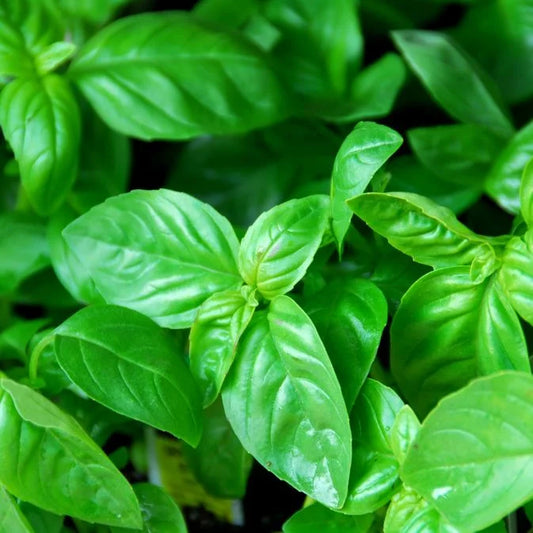
How To Grow Basil
Botanical Name: Ocimum Basilicum Basil is a widely used herb in the mint family, native to tropical areas of Central Africa and Southeast Asia. It has fragrant leaves and is...
Read More >How To Grow Basil
Botanical Name: Ocimum Basilicum Basil is a widely used herb in the mint family, native to tropical areas of Central Africa and Southeast Asia. It has fragrant leaves and is...
Read More >


